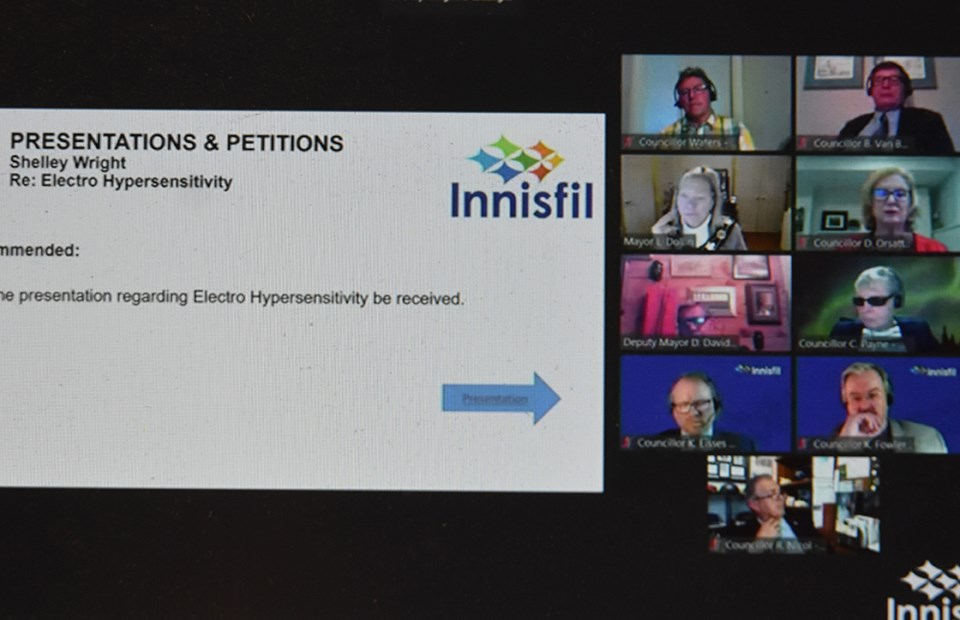According to Innisfil resident Shelley Wright, between five and eight percent of the population suffer from Electromagnetic Hypersensitivity, or EHS.
A disability recognized in Sweden since 2000, the U.S. since 2002, and by the Canadian Human Rights Commission in 2007, EHS is a disability triggered by electromagnetic and microwave frequencies, that can result in debilitating headaches, head pressure, slurred speech, migraines, loss of executive functioning, even skin rashes.
Those who are vulnerable include the very young – “Children are more vulnerable. Their skulls are thinner, their cells are growing faster,” Wright explained – as well as those suffering from immune-deficient diseases, concussion, or repeated toxic exposures.
Wright herself was diagnosed with the disability at Women’s College Hospital: certain genetic markers were identified that make her susceptible.
Since then, she has become an advocate for recognition of the disability, promoting the steps that can be taken to mitigate the isolation, loss of participation and loss of function that those with EHS can experience in a ‘wireless’ community.
On Wednesday night, Wright made a presentation to Innisfil Council, calling on the Town to limit cell towers, and take other steps that would make the town more accessible to those with EHS.
“With the government’s push for broadband, what are Innisfil’s accessibility plans for electro-sensitive residents?” she asked, noting that at present she is unable to attend locations that include the Town Hall, YMCA, library, even grocery stores and restaurants, due to the presence of nearby cell towers and antennas, WiFi hot spots and cell phones.
Instead of cell towers, she urged the municipality to look at ‘hard-wiring’ access to the internet, by providing fibre optic connectivity
“Hard-wired technology is better for everyone,” said Wright. “Stop the proliferation of 3G, 4G and 5G.”
She was particularly opposed to plans to install mini-towers along public right-of-ways, for future 5G service – a move that would make roads and sidewalks areas of exposure for anyone susceptible and suffering from EHS.
Asking for “appropriate accommodation” for EHS disabled residents, Wright called on the Town to:
. minimize the construction of cell towers, and encourage multiple users to co-locate on a single tower.
. direct signals away from schools and daycare centres.
. avoid locating towers near road intersections, where changing lights could result in longer exposures for those with EHS.
. encourage those in gatherings and public spaces to turn their cell phones to airplane mode, and residents to limit their in-home WiFi signals so there is no spill-over to the street.
. limit radiation to 10 microWatts per sq. meter
Finally, she said, “Stop the proliferation of 5G mini cell towers.”
Council received her presentation, and had some questions.
Coun. Alex Waters wanted to know if Elon Musk’s new Starlink satellite system provided “a solution besides hard-wiring?”
Wright acknowledged that satellite signals are weaker, therefore safer – but noted that they still require on-ground transmission towers to provide the service.
“The towers are what really creates the problem,” she said. “It’s proximity to source, and duration of exposure.”
Coun. Kevin Eisses noted that for residents in rural areas, “it’s unlikely they will have access to fibre optics.” How, he wondered, would they get broadband access without WiFi?
Wright acknowledged the need, but suggested that the Town could create low-exposure areas, safe for those with EHS, by keeping cell towers away from beaches, parks and schools, and by monitoring to ensure low emissions of 10 microwatts per sq.m. in areas where the EHS-disabled live.
“Those are solutions that are available,” she said.
Asked by Coun. Bill Van Berkel about the number of people impacted by the disability, Wright cited the five to eight percent statistic as severely electro-sensitive, but noted that up to 35 percent of the population may experience mild to moderate reactions, including impacts on the endocrine system,the production of free radicals, inflammation and other health impacts.
She suggested that most may not realize the causes of their symptoms.
“Is this age related? And how does one get tested?” asked Coun. Carolyn Payne. Payne, noting that she lives between communications towers, and suffers from migraine headaches, said, “This is ringing bells for me.”
Wright explained that a physician at Women’s College Hospital provides testing, but there is currently a two-year waiting list. She directed the councillor to a number of websites, including the Electrosensitivity Society, and Canadians For Safe Technology (C4ST).
“If you are concerned, document your triggers, when you are sensitive,” she said, also suggesting that Payne remove wireless sources from her home “and see if it makes a difference.”
Wright’s presentation, which has also been given to the Innisfil Accessibility Advisory Committee, was received by council with thanks.
